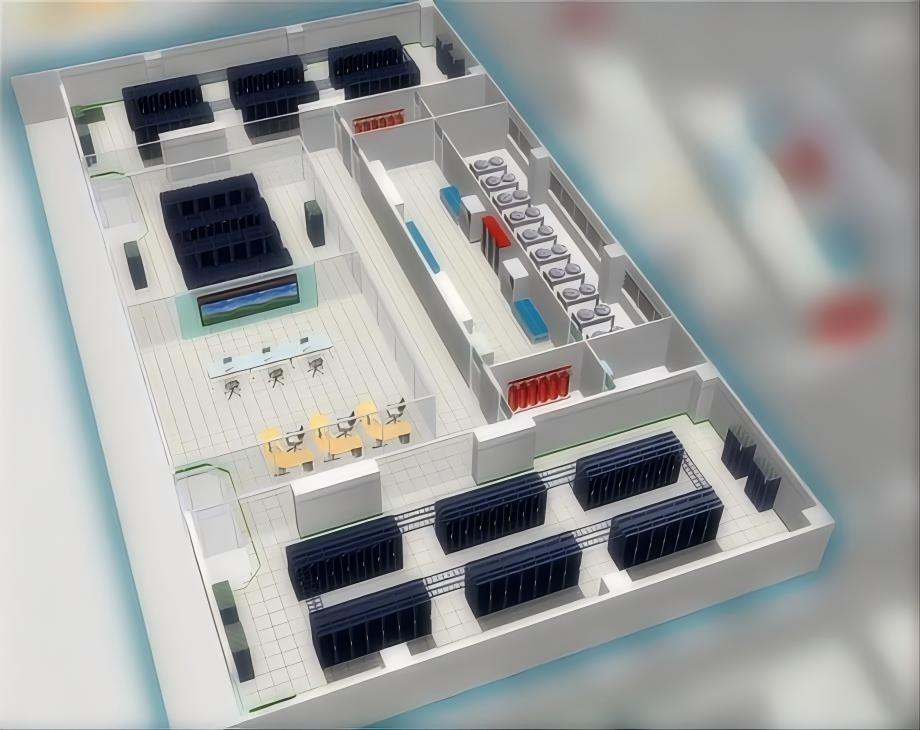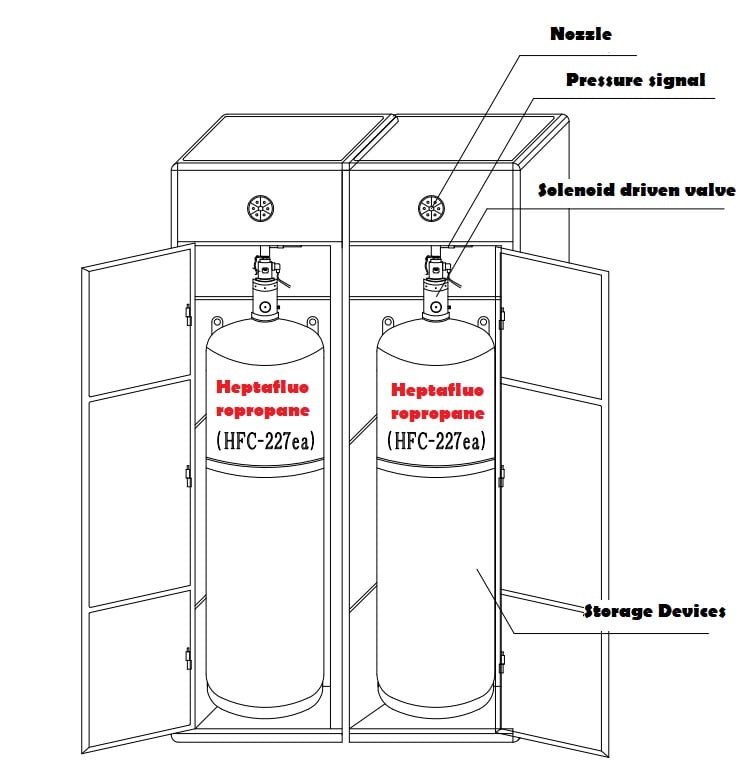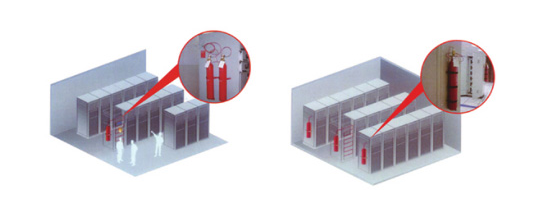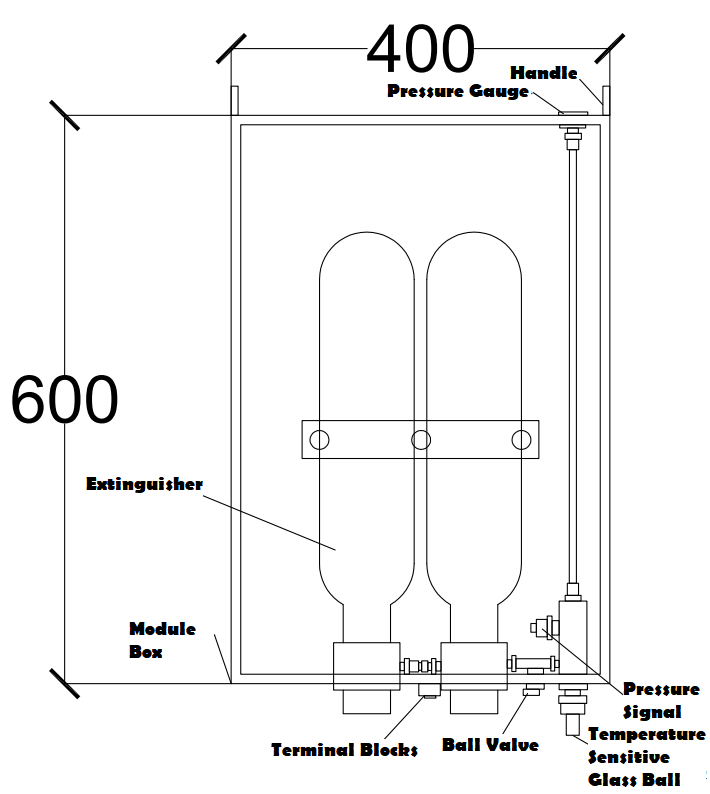NEWS TAG
brand
Server Room Fire Suppression & Protection System (Extinguisher & Alarm Equipment)
A well-designed fire suppression system is important for ensuring the safety and longevity of IT equipment in server rooms, as these spaces house sensitive and essential data for businesses. The unique requirements of IT equipment require specialized fire-fighting solutions, as traditional methods like water, foam, or powder extinguishers can cause significant damage. Instead, gas-based fire suppression systems, particularly those using HFC-227ea (Heptafluoropropane), are the preferred choice in server rooms.
Server room fire protection is not just about extinguishing fires but also ensuring the continued operation of the IT infrastructure. As such, it is essential to understand the various types of fire suppression systems available for different environments and needs.
Server Room Fire Suppression Systems
Server rooms are critical departments in every organization, as they handle and store core data through the IT systems. The proper functioning of these systems is crucial for business continuity. IT equipment has specific fire safety requirements, and a well-designed fire protection system is necessary to ensure the continued operation of these systems. Water, foam, and powder extinguishers are unsuitable for server rooms, as they can damage sensitive electronics. Instead, gas-based fire suppression systems, like HFC-227ea, are recommended.

Additionally, the construction of computer rooms integrates various technical fields, including architecture, electrical engineering, installation, and networking. The design and construction quality directly affect the reliability and stability of the computer systems. Thus, a well-built server room must meet specific environmental requirements, including temperature, humidity, noise levels, and electromagnetic interference control.
Types of Fire Suppression Systems for Server Rooms
1. Classification by Installation Method
Server room fire suppression systems can be classified based on their installation methods:
Piped Systems: These systems use a network of pipes to deliver the fire suppression agent. They are typically used in larger server rooms.
Non-Piped (Cabinet) Systems: These are standalone systems that do not require extensive piping. They are ideal for smaller rooms or specific areas.
Rack-Mounted Systems: These are designed for small, enclosed spaces such as equipment racks or modular server rooms.
Fire Detection Tube Systems: These systems use flexible tubes that detect fire and release the suppression agent directly onto the fire source.
2. Classification by Extinguishing Agent
Based on the extinguishing agent, server room fire suppression systems can be classified into two types:
HFC-227ea (Heptafluoropropane): This clean agent is the most commonly used gas for server room fire suppression due to its non-conductive and non-corrosive properties. It is safe for electronic equipment.
Aerosol Extinguishers: Also known as K-type aerosol, these systems have high fire-fighting efficiency but are unsuitable for server rooms due to their lower cleanliness standards.
Non-Piped Gas Fire Suppression Systems
Non-piped gas fire suppression systems, such as cabinet-based HFC-227ea systems, are ideal for server rooms. These systems are self-contained, compact, and do not require additional piping. Cabinet systems deliver the agent directly into the protected area, making them fast and efficient, with minimal installation requirements. These systems can be connected to the fire control center and triggered automatically by fire alarms.

Advantages of Non-Piped Systems:
High efficiency and fast response.
Compact design with no need for separate equipment rooms.
Easy to install and aesthetically pleasing.
Safe for electronic equipment and environmentally friendly.
Application:
Non-piped systems are ideal for data centers, communication rooms, electrical rooms, and archives where traditional extinguishing agents such as water cannot be used. They are also suitable for areas where valuable or sensitive materials are stored.
Piped Gas Fire Suppression Systems
Piped systems use a network of pipes to deliver the extinguishing agent over larger areas. The core extinguishing agent, HFC-227ea, is a clean, non-conductive, and environmentally safe gas. Piped systems can cover larger areas compared to cabinet systems, making them ideal for extensive server rooms or facilities with a large footprint.

Advantages of Piped Systems:
Ability to cover large areas by transporting the agent through pipes.
Flexible installation options to meet specific layout needs.
Fast-acting and efficient fire suppression.
Application:
Piped systems are best suited for large server rooms, generator rooms, electrical rooms, libraries, and archives. They are also highly effective in environments where precision equipment is housed, such as medical device rooms and chemical labs.
Fire Detection Tube Systems
Fire detection tube systems are distinguished by their simplicity and effectiveness. These systems use a flexible fire detection tube that acts as both a detection and distribution mechanism for the extinguishing agent.

Advantages:
No need for power or traditional control systems, making them highly independent.
Quick response to fire due to the proximity of the detection tube to potential fire sources.
Ease of installation and lower cost, as no additional piping or control systems are required.
Application:
These systems are particularly effective for small, enclosed spaces such as control cabinets, electrical boxes, and integrated server racks. Fire detection tube systems are reliable, and cost-effective, and reduce the overall volume of extinguishing agents used by up to 80%.
Rack-Mounted Fire Suppression Systems
Rack-mounted systems are designed to protect individual server racks by placing fire suppression systems directly within the racks. These systems use perfluorohexanone as the extinguishing agent, which is stored in small containers within the rack.

Advantages:
Fast and localized fire suppression, ensuring minimal damage to surrounding equipment.
Compact design, making it an ideal solution for high-density server environments.
Application:
Rack-mounted systems are optimal for data centers and server rooms with high densities of equipment where localized protection is critical.
Comparison of Different Server Room Fire Suppression
| Advantages | Rack-Mounted Fire Suppression System | Fire Detection Tube | Cabinet Gas Fire Suppression System |
|---|---|---|---|
| Reliability | Targets internal protection; close to fire source; full-coverage fire suppression. Ensures zero dead zones and reliable protection. Modular design for easy product replacement. High reliability. | Targets internal protection; used for partial protection; can be affected by the equipment inside the rack. | Targets room protection; difficult to seal the room; more steps involved in project installation, increasing the likelihood of issues. |
| Safety | Targets rack fire suppression without affecting surrounding equipment; low risk of false alarms; moderate cost. Safety rate of 60%-80%. | Generally lasts 3 years before aging becomes apparent. If not replaced in time, there is a high risk of malfunction. Vulnerable to damage from daily operations, which may cause leaks. | Once installed, it heavily depends on room sealing. More complex installation increases the risk of potential hazards. |
| Space Efficiency | Standard 19-inch rack-mounted design, occupies just 2U space, the size of one server. | Requires additional space for installation, typically 2-3U. | Dedicated space is required for standalone installation in the room. |
| Ease of Installation & Maintenance | Installation is simple, no additional piping or engineering required. | Requires on-site gas filling, pressurization, and engineering support. | Requires engineering support, fire protection inspection, and verification. |
| Aesthetics | Integrates seamlessly with existing equipment, maintaining a uniform appearance. | Requires additional piping, which may affect aesthetics. | The external system is visible, which contrasts with the server rack and affects the overall appearance. |
When it comes to server room fire suppression, it is essential to choose the right system based on the size, layout, and specific needs of the data center. Gas-based systems, especially those using HFC-227ea, offer the best protection for sensitive electronic equipment. Both piped and non-piped systems have their advantages, depending on the size of the area to be protected. Additionally, fire detection tube and rack-mounted systems provide targeted protection for smaller enclosures and high-density equipment spaces.
By selecting the appropriate fire suppression system, organizations can ensure the safety of their critical IT infrastructure while minimizing the risk of damage during a fire.
